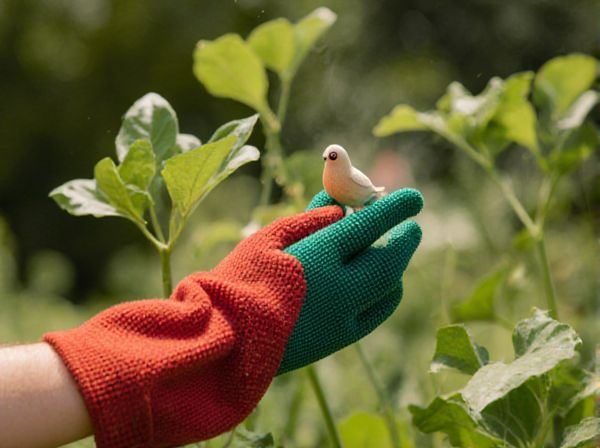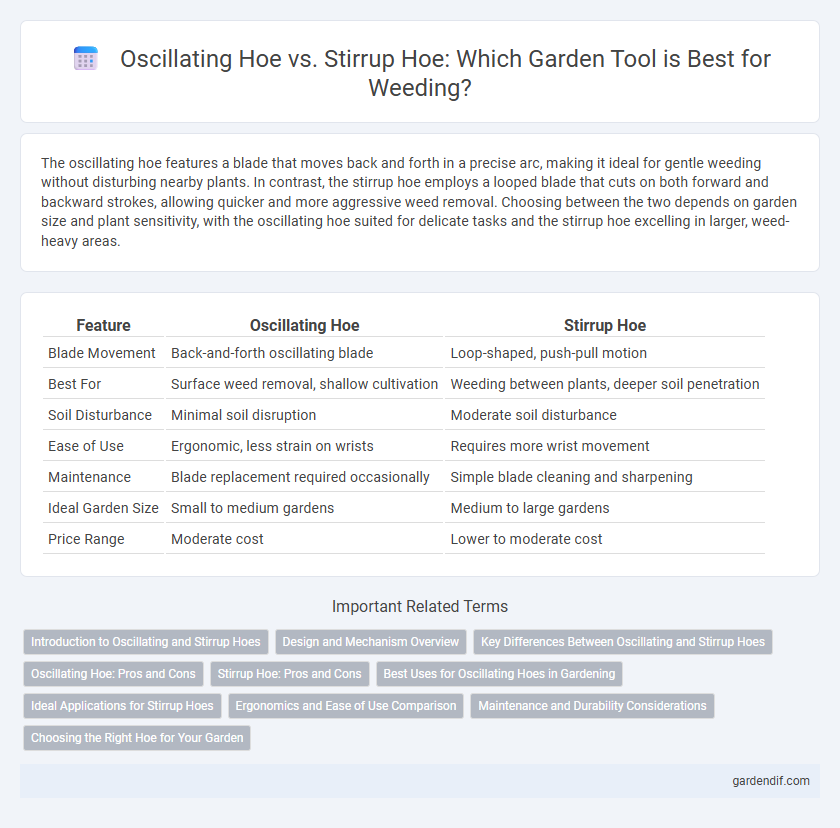
Oscillating Hoe vs Stirrup Hoe Illustration
The oscillating hoe features a blade that moves back and forth in a precise arc, making it ideal for gentle weeding without disturbing nearby plants. In contrast, the stirrup hoe employs a looped blade that cuts on both forward and backward strokes, allowing quicker and more aggressive weed removal. Choosing between the two depends on garden size and plant sensitivity, with the oscillating hoe suited for delicate tasks and the stirrup hoe excelling in larger, weed-heavy areas.
Table of Comparison
| Feature | Oscillating Hoe | Stirrup Hoe |
|---|---|---|
| Blade Movement | Back-and-forth oscillating blade | Loop-shaped, push-pull motion |
| Best For | Surface weed removal, shallow cultivation | Weeding between plants, deeper soil penetration |
| Soil Disturbance | Minimal soil disruption | Moderate soil disturbance |
| Ease of Use | Ergonomic, less strain on wrists | Requires more wrist movement |
| Maintenance | Blade replacement required occasionally | Simple blade cleaning and sharpening |
| Ideal Garden Size | Small to medium gardens | Medium to large gardens |
| Price Range | Moderate cost | Lower to moderate cost |
Introduction to Oscillating and Stirrup Hoes
Oscillating hoes feature a blade that moves back and forth in a precise arc, making it ideal for cutting weeds just below the soil surface with minimal soil disturbance. Stirrup hoes, also known as scuffle hoes, have a looped blade that moves in a push-pull motion, efficiently slicing through weeds at the root level. Both types offer ergonomic benefits for gardeners, but their unique blade designs cater to different weeding techniques and soil conditions.
Design and Mechanism Overview
Oscillating hoes feature a blade that moves back and forth in a swift, pendulum-like motion, allowing for precise soil cultivation and weed removal with minimal effort. Stirrup hoes, also known as hula hoes, employ a looped blade that cuts weeds on both the push and pull strokes, using a scissors-like action ideal for shallow weeding. The oscillating hoe's mechanical advantage reduces user fatigue through smooth, controlled oscillations, while the stirrup hoe's simple, double-edged blade mechanism excels in maneuverability and rapid weed cutting.
Key Differences Between Oscillating and Stirrup Hoes
Oscillating hoes feature a blade that moves back and forth in a grinding motion, allowing for precise soil cutting and weed uprooting with minimal soil disturbance. Stirrup hoes have a looped, stirrup-shaped blade that cuts weeds just below the soil surface through a push-pull motion, making them highly efficient for larger areas. The oscillating hoe excels in tight spaces and delicate garden beds, while the stirrup hoe is preferred for faster coverage on open ground.
Oscillating Hoe: Pros and Cons
The oscillating hoe features a blade that moves back and forth, making it highly efficient for cutting weeds just below the soil surface without disturbing nearby plants, ideal for precise garden maintenance. Its ergonomic design reduces wrist strain, allowing for longer use compared to manual hoeing methods, but the oscillating motion can be less effective in compacted or rocky soil conditions where the blade may struggle to penetrate deeply. While offering superior control and minimal soil disruption, the oscillating hoe typically requires regular sharpening to maintain cutting efficiency, unlike the simpler, sturdier stirrup hoe which excels in tougher terrain.
Stirrup Hoe: Pros and Cons
The stirrup hoe features a unique looped blade that efficiently cuts weeds just below the soil surface, making it ideal for precision weeding in tight garden spaces. Its lightweight design reduces user fatigue during extended use and allows for swift back-and-forth motions, increasing productivity compared to the oscillating hoe. However, it may struggle with tougher, deeply rooted weeds and requires more physical effort on compacted soil, limiting its effectiveness in heavy-duty gardening tasks.
Best Uses for Oscillating Hoes in Gardening
Oscillating hoes excel in gardening by efficiently cutting through soil and weeds just below the surface with their rapid back-and-forth blade motion, making them ideal for cultivating flower beds and vegetable patches without damaging nearby plants. Their precision and ease of use allow gardeners to aerate soil and remove shallow-rooted weeds in tight spaces, enhancing plant growth and soil health. This tool performs best in soft to moderately compacted soils where careful weeding and soil preparation are essential for maintaining healthy garden beds.
Ideal Applications for Stirrup Hoes
Stirrup hoes excel in light weed control and cultivation in tightly spaced garden beds or row crops, allowing for precise surface weeding without disturbing crop roots. Their looped blade design efficiently cuts weeds just below the soil surface, ideal for shallow cultivation and maintaining soil aeration. Best suited for annual weeds and delicate plants, stirrup hoes provide ergonomic benefits and reduce hand strain during prolonged gardening sessions.
Ergonomics and Ease of Use Comparison
The oscillating hoe features a pivoting blade that reduces wrist strain and enhances precision when cutting weeds near the soil surface, making it ergonomically superior for extended use. In contrast, the stirrup hoe's continuous back-and-forth motion demands more wrist movement, which may cause fatigue but allows for rapid weeding over larger areas. Both tools provide ergonomic benefits in different contexts, with the oscillating hoe favoring controlled, low-impact use and the stirrup hoe excelling in swift, broad weed removal.
Maintenance and Durability Considerations
Oscillating hoes feature fewer moving parts, requiring minimal maintenance and offering enhanced durability for long-term garden use. Stirrup hoes, with their pivoting blade design, demand regular blade sharpening and occasional tightening of fasteners to maintain optimal performance. Choosing between these tools depends on balancing maintenance time against expected durability in varying soil conditions.
Choosing the Right Hoe for Your Garden
Selecting the right hoe for your garden hinges on the specific weeding needs and soil conditions. An oscillating hoe, with its back-and-forth blade motion, excels at cutting through tough, compact soil and disrupting weed roots beneath the surface. In contrast, a stirrup hoe features a looped blade ideal for slicing weeds just below the soil surface in lighter, looser soil, making it highly efficient for shallow cultivation and frequent, precise weeding.
Oscillating Hoe vs Stirrup Hoe Infographic

 gardendif.com
gardendif.com